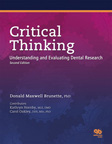 |
|||||||||
|
ADDITIONAL EXERCISES IN CRITICAL THINKING
The following excerpts from the dental literature are intended to provide further illustrations of some of the concepts introduced in chapter 22 of Critical Thinking, Second Edition. The examples have been extracted from papers, and much detail has been omitted. In some instances, the authors discuss the weaknesses or strengths of the particular approach they employed in their article (which is not included here). The intent in presenting these examples is not to criticize or commend the articles in question, but rather to show how the arguments, strategies, and ideas discussed in the book appear in the dental (or popular) literature. To provide a wide range of examples in a reasonable amount of space, only select material was extracted from the papers. Often the problems contain a conclusion drawn from the abstract or summary of the paper and select material from other sections of the paper, such as Materials and Methods and Results, relevant to the conclusion. In approaching these problems, you should assume that the aspects of the conclusions that are not concerned with the information presented in the Materials and Methods and Results extracts are not problematic. Comments on these Problems can be found at the end of Problem 48. |
STATISTICAL APPLETS
The following collection of Statistical Applets is not to be considered as a stand alone statistics program but rather as an adjunct to the material in Critical Thinking 2nd Edition. Thus the comments attached to this web-based material are brief but references are made to the relevant pages of the textbook. There are several ways that these applets can be used:
|
||||||||
|
|
|||||||||
 |
|||||||||